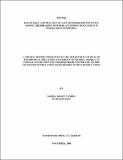UNNSpace Repository
Knowledge and Practice of Safe Motherhood Initiative Among Childbearing Mothers Attending Mch Clinics in Nsukka Health District
JavaScript is disabled for your browser. Some features of this site may not work without it.
| dc.contributor.author | ADAMA, GRACE N.
|
|
| dc.date.accessioned | 2017-03-22T12:34:00Z | |
| dc.date.available | 2017-03-22T12:34:00Z | |
| dc.date.issued | 2017-03-22 | |
| dc.identifier.uri | http://hdl.handle.net/123456789/4133 | |
| dc.description.abstract | Unprecedented maternal mortality and morbidity rates, foetal deaths, pregnancy and birth complications emanating from dearth of knowledge and practice of safe motherhood among childbearing mothers due to non-att endance of MCH clinics culminate into a monumental public health problem in many developing nations of the world including Nigeria. Considerable variations in the magnitude of this quandary exist within and between states and regions of Nigeria including Enugu State. Consequently, the present study was an attempt to investigate knowledge and practice of safe motherhood initiative among childbearing mothers attending MCH clinics in Nsukka Health District. Well-completed 363, self-designed Childbearing Mothers Knowledge and Practice of Safe Motherhood Questionnaire-CMKPSQ (that consisted of three sections A, B, and C) returned by childbearing mothers of four out of five functional randomly selected MCH clinics in Nsukka Health District were analyzed. Split-half was used to determine reliability of instrument (CMKPSQ) while Spearman-Brown Prophecy (correction) Formula was used to establish reliability co-efficient of the sub-scales. Cronbach’s (1951) alpha was utilized to established inter-item correlation co-efficient of items in Section B, which elicited data on KOPC of childbearing mothers while factor analysis statistic was employed to determine sub-scale reliability co-efficient of Section B. Kuder-Richardson-21 formula was used to determine internal consistency of Section C of CMKPSQ which comprised dichotomously-scored items of ‘Yes’ or ‘No’. Percentages using a slightly modified version of Okafor’s (1997) modified Ashur’s (1977) criteria for describing level of knowledge were utilized for answering the principal research questions while T-test statistic was adopted to verify null hypotheses one and five, Chi-square ( 2) was utilized for verification of postulated null hypotheses two, four and six while ANOVA was employed to analyze null hypothesis three. Results revealed that childbearing mothers had high knowledge of various components of safe motherhood initiative while childbearing mothers also practised safe motherhood. The independent variables (age, level of education and location) considered had significant influence, at .05 level of significance on knowledge and practice of safe motherhood among childbearing mothers. | en_US |
| dc.language.iso | en | en_US |
| dc.subject | Knowledge | en_US |
| dc.subject | Practice | en_US |
| dc.subject | Motherhood | en_US |
| dc.subject | Childbearing | en_US |
| dc.subject | Clinics | en_US |
| dc.subject | Health District | en_US |
| dc.title | Knowledge and Practice of Safe Motherhood Initiative Among Childbearing Mothers Attending Mch Clinics in Nsukka Health District | en_US |
| dc.type | Thesis | en_US |
